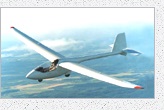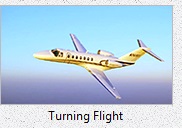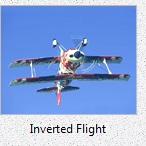Common
Fears
 |
 AVE YOU EVER watched
a balloon as it slowly meandered upward into the
sky? AVE YOU EVER watched
a balloon as it slowly meandered upward into the
sky?
 The balloon is able to fly
because the air within it is lighter than the surrounding air—just set
it free and it’s off. The balloon is able to fly
because the air within it is lighter than the surrounding air—just set
it free and it’s off.
Many people think
quite differently about airplanes, however. Knowing that these machines are
clearly heavier than air, they might wonder what exactly keeps an airplane
in the sky. And they might fear that any airplane might just fall out of
the sky. In fact, to some people, airplanes seem more at peace sitting on
the ground than they do in the air.
Perhaps during
a recent flight you found yourself worrying about some of the
following:
• |
A wing might
fall off |
• |
One of the engines
might stop |
• |
Turbulence might
make the plane tip over and lose control |
• |
The plane might
fall from the sky and crash |
If so, this page
will help you understand some basic principles of aircraft flight. You’ll
learn that many fears are unfounded, and that some feared events not only
are improbable but also are not as dangerous as might be believed. |
“Lift”
Keeps
the
Airplane
Up
 |
Although aerodynamics
is a very complicated topic, one simplistic statement sums up the basic principle
of flight: An airplane stays up because its wings push the air
down.[1]
This is called “lift.”
An airplane generates
lift, however, only when it is moving. This is completely different than
a lighter-than-air balloon. It’s also common sense, because we all know
that parked airplanes—even taxiing airplanes—are not flying. An
airplane flies only when it builds up enough speed in the take-off run. At
take-off, the wings have sufficient airspeed to “push down” hard
enough on the air to overcome the airplane’s weight.
But this is not
the whole story.
 It’s a common mistake
to confuse an airplane’s ability to fly with the need for an engine
to push or pull it through the air. Consider that gliders can stay aloft
for hours riding rising air currents, but if a glider is towed aloft and
finds the air not good for sailing, it turns around and glides back down
to the airport. The principle here is this: Altitude can always be “traded
in” for airspeed. It’s a common mistake
to confuse an airplane’s ability to fly with the need for an engine
to push or pull it through the air. Consider that gliders can stay aloft
for hours riding rising air currents, but if a glider is towed aloft and
finds the air not good for sailing, it turns around and glides back down
to the airport. The principle here is this: Altitude can always be “traded
in” for airspeed.
The same thing
is true for regular airplanes. Even with all the engines stopped an airplane
can glide back down. Of course, it won’t glide as well as a sailplane,
and it can’t climb in an updraft, but it won’t fall like a rock
either. Its altitude will be traded for airspeed, and the airspeed will generate
enough lift to fly it back down to the ground for a safe landing.
You can also
rest assured that pilots are specifically trained to fly an airplane with
any number of engines—including all of them—not working. (And on
jets, if an engine catches fire, built-in fire extinguishers will put out
the fire.) Getting back to the ground after an emergency might be scary,
but you will likely survive. |
Turning
Flight
 |
Many persons become
frightened when an airplane makes a steep turn. Usually, passenger aircraft
keep their turns shallow for just this reason, but sometimes, especially
on take off, noise abatement regulations require a sharp turn to avoid
noise-sensitive areas on the ground.
 In this regard, it’s
important to know that an airplane does not turn with its rudder, like a
boat in the water; it must bank its wings to turn. Aerodynamically, the wings
must generate some extra lift to pull the plane around in the turn; this
extra lift generates a considerable centrifugal force. Pilots often describe
this as pulling +Gz. This force is measured in units of gravity, so a moderately
steep 2G turn draws as much force as twice the pull of gravity. So you, as
a passenger within the turning airplane, will feel pulled down into your
seat as a result. In this regard, it’s
important to know that an airplane does not turn with its rudder, like a
boat in the water; it must bank its wings to turn. Aerodynamically, the wings
must generate some extra lift to pull the plane around in the turn; this
extra lift generates a considerable centrifugal force. Pilots often describe
this as pulling +Gz. This force is measured in units of gravity, so a moderately
steep 2G turn draws as much force as twice the pull of gravity. So you, as
a passenger within the turning airplane, will feel pulled down into your
seat as a result.
 This is not a sign that
the airplane is about to tip over, as some people fear. An airplane can bank
as much as it wants. This is not a sign that
the airplane is about to tip over, as some people fear. An airplane can bank
as much as it wants.
 The
airplane can actually fly quite well when it is upside down (although any
cabin items and passengers that are not securely fastened down will have
problems). In fact, aerobatic pilots—and I, a private pilot myself,
have flown aerobatics just for fun—take great delight in flying upside
down (inverted flight), on edge (knife-edge flight), and going all the way
around (a roll). The
airplane can actually fly quite well when it is upside down (although any
cabin items and passengers that are not securely fastened down will have
problems). In fact, aerobatic pilots—and I, a private pilot myself,
have flown aerobatics just for fun—take great delight in flying upside
down (inverted flight), on edge (knife-edge flight), and going all the way
around (a roll). |
The
Sounds
of
Flight
 |
Many strange sounds
that occur during the course of a flight can be disturbing if you do not
know what causes them. The following are a few sounds you might try to
recognize:
• |
Just after take-off the landing gear
will be retracted, causing a thumping sound. |
•
|
You might also hear a whirring sound
as a motor retracts the flaps and spoilers. (These are made to stick out
of the back of the wings in order to add extra lift on take-off and to help
slow the airplane on descent.) |
• |
You might hear the engines throttle
back when leveling off for cruise. |
• |
You might hear whirring sounds as
flaps and spoilers are extended for descent and landing. |
• |
Finally, before landing, you will
hear thumping as the landing gear comes down. |
|
Turbulence:
The
Basics
 |
Surprising as it is
to most people, an airplane moves through air that is itself moving. Moving
air flows in ways that are quite similar to moving water, only we cannot
see the air currents like we can see the swirls and ripples of
water.
Air currents
vary, and flying rapidly from one current to another is what leads to the
feeling of turbulence. Some people call this “hitting an air pocket,”
but this description is a misnomer. The jolt comes not from falling into
a “hole” in the air but from crossing a barrier between different
currents.
There are several
causes of turbulence:
•
|
Convective
currents result from the sun heating the
ground, causing air to rise. As the air rises, it cools and forms
clouds—those pretty, white, fluffy cumulus clouds that look so nice
and soft on the outside and are boiling with activity inside. Hence pilots
are always looking for smooth air above the clouds where the convection
stops.
After sunset
the air is generally much smoother because of a lack of convective activity.
But other forms of turbulence can occur at any time, even at
night: |
• |
Obstructions
to wind flow cause all kinds of eddies and
currents. On a city street you may have seen papers blowing around in circles
between buildings; in an airplane you will notice this kind of turbulence
when flying over mountains; e.g., especially on the eastern side of the Rockies
in the US and over the Alps in Europe. |
• |
Wind
shear occurs at the boundary between winds
that differ in speed or direction, or both. Common near temperature inversions
and at the border between weather fronts, this kind of turbulence is most
likely encountered in a large aircraft at high altitudes near the
jet stream. |
|
Turbulence:
The
Dangers
 |
Although turbulence
is generally not dangerous, it would be a lie to say that it is never dangerous.
So let’s sort out the dangerous aspects of it.
The
Background
Commercial aircraft
prefer to fly “straight and level” (at a constant heading and altitude)
because it is convenient. First of all, air traffic controllers have to keep
aircraft from flying into each other, and having pilots fly at predictable
paths during each segment of a flight makes a controller’s job possible.
Second, people tend to get airsick when an airplane moves erratically, so
straight and level flight makes things more comfortable for the passengers
and crew. And third, because the shortest distance between two points is
a straight line, straight and level flight makes for economy. (Actually,
since the earth’s surface is curved, aircraft routes are always curves,
not straight lines—but that fact doesn’t matter to this
discussion.)
When an aircraft
flies through turbulent air, though, it will tend to rock its wings and dip
and bob, all because the air in which it is flying is moving erratically. There
is nothing dangerous about this because there is no physical law that says an
airplane has to fly in a straight line at a constant altitude. For example, if
you watch an aerobatic airshow you will realize that airplanes can fly
in all sorts of positions—upside down, straight up, straight down, sideways,
and, for a short time, even backwards—and still be perfectly safe. So, even
though level flight may be preferred, if an airplane enters turbulent air, its
erratic flight poses no real safety issue to the airplane itself. Usually.
So here is
the first real danger of turbulence:
Structural Failure
According to
FAA regulations, all aircraft are designed and built to withstand far more
stress than occurs in normal flight, including ordinary turbulence. But the
turbulent air in severe thunderstorms can be so powerful that it can literally
rip a small airplane to pieces.
 Now, I’m talking
here about the danger of flying right into the middle of the biggest and
meanest thunderclouds there are. No competent pilot would ever do that
deliberately. Now, I’m talking
here about the danger of flying right into the middle of the biggest and
meanest thunderclouds there are. No competent pilot would ever do that
deliberately.
It is true that
small, general aviation airplanes have often gotten destroyed in thunderstorms,
all because the pilot was flying in the clouds and, not having on-board radar
to distinguish a thunderstorm from the surrounding clouds, inadvertently
flew right into a big thundercloud.
But commercial
aviation has a far better history than general aviation. Dispatchers who plan
the flights will route flights away from thunderstorms. Sometimes they will
even cancel flights because of thunderstorms. Pilots of commercial aircraft also
have on-board radar to spot and avoid thunderstorms, and they will often request
a course change to avoid bad weather. So, if your flight is delayed or cancelled
because of weather, be grateful, not angry.
The second
real danger of turbulence:
Passenger Injury
When an airplane
flies into downward-moving air, the airplane will drop with the air. But
anything not securely attached to the airplane itself—such as food service
items and passengers who are not strapped to their seats—can get thrown
around the cabin.
You should be
aware that turbulence can be forecast by aviation weather services, so pilots
are likely to be aware of it in advance and will try to avoid it. This explains
why the “Fasten Seat Belts” sign comes on well before the bumps
start. Occasionally, though, turbulence (such as “clear air
turbulence” which doesn’t have any clouds around it to give a visual
warning) can be unexpected.
|
Many passengers
who get injured because of turbulence are those who, unlike more experienced
travelers, do not keep their seat belts loosely fastened at all times.
To be safe, you might want to remember that any time you unfasten your seat
belt, whether to feel more “comfortable” or to get up from your
seat—regardless of whether or not the seat belt sign is
off—you’re risking injury from sudden turbulence. Although injury
from turbulence is rare, if you keep in mind that walking around an airplane
cabin is not as simple and safe as walking around your living room, you can
help to keep yourself safe. |
|
The third
real danger of turbulence:
Altitude Loss Near the Ground.
Sudden altitude
changes can also be a consequence of flying in turbulent air. When you are
thousands of feet above the ground, a few hundred feet of altitude loss
doesn’t count for much. But if the airplane is only a few hundred feet
above the ground, as when it is in the process of taking off or landing,
then a few hundred feet of altitude loss can make all the difference in the
world.
Severe turbulence
near the ground is usually the result of one of two things:
1.
|
Wake
turbulence occurs when an aircraft leaves
a trail of disturbed air behind it simply as a result of its flying through
the air. This turbulence is greatest when it is flying slowly during take-off
or landing. The turbulence poses no danger to the aircraft itself, but any
other aircraft following too closely behind it can fly into the turbulent
air and lose control. For this reason, air traffic controllers maintain strict
limits of spacing between aircraft, both on arrival and departure. This concern
for safety can cause traffic delays, but they are well worth the safety
advantage. |
2. |
Thunderstorms, as I mentioned above, can cause big problems for airplanes
flying near them, especially because the storms can produce strong, unexpected
downdrafts. And there have been planes that crashed while landing all because
the plane dropped onto the ground before it could recover from a sudden
downdraft. Thankfully, these accidents of the past have only made pilots
more aware of the problem of sudden wind shifts during take-off and landing.
In addition, many airports now have special detectors to warn pilots of unusual
wind behavior in the vicinity of the airport. |
The fourth
real danger of turbulence:
Wind Changes Near the Ground.
Turbulent air
aloft is not a problem in regard to an aircraft’s airspeed, because
no matter how fast the wind is “blowing,” and no matter whether
the aircraft is flying “with” or “against” the wind,
all that matters aerodynamically is that the aircraft be moving sufficiently
fast relative to the air around it to generate the lift necessary to keep
flying.
For example,
if an aircraft’s airspeed is 300 knots that means it is moving through
the air mass around it at 300 knots. If that same mass of air is also moving
(relative to the ground) at 300 knots opposite to the direction the aircraft
is flying, the aircraft’s airspeed is still 300 knots. Even though we
might think that the aircraft is flying “against” the wind, it
is really flying quite safely within a moving air mass.
In the above
example, although the aircraft has an airspeed of 300 knots, its groundspeed
is 0 knots. Technically, it is hovering over the ground because the air is
moving it backwards (relative to the ground) at the same rate as the aircraft
is flying forwards (relative to the ground). Of course, my example of wind
blowing at 300 knots is highly exaggerated, even in the jet stream, and I
use the example just to make the point about groundspeed easier to comprehend.
More realistically, though, if you watch gliding birds such as hawks and
seagulls, you can occasionally see them hover over one spot on the ground
just by pointing themselves into the wind and matching their airspeed with
the speed of the wind.
On the other
hand, if the aircraft flies in an air mass moving in the same direction as
the aircraft, the aircraft’s groundspeed will be increased, sometimes
dramatically. In fact, air travel across the US from the west coast to the
east coast can be greatly facilitated by flying in the west-to-east jet stream.
(Flying east-to-west, of course, airplanes avoid the jet stream as best as
possible—otherwise, they might end up hovering above the ground, and
that’s not an effective way to travel anywhere. For information about
the jet stream in other countries, see the link
below.)
OK. So understanding
this much about airspeed and groundspeed, you can now grasp the safety problem
in regard to wind changes when the aircraft is near the ground. If the aircraft
is just about to land and suddenly the wind changes to a tail wind, the plane
can actually get “blown” right off the end of the runway. In fact,
several aircraft accidents have happened like this. In trying to land in
the vicinity of a thunderstorm, pilots under pressure to land, rather than
divert to another airport, have been surprised by strong, erratic winds and,
on touchdown, have landed too far down the runway, lost control, and slid
right off the runway.
|
Please note that
sudden, unpredictable wind changes near the ground usually happen
because of a thunderstorm in the vicinity of the airport. Wind changes
can happen because of a larger weather system such as a front, but such wind
changes are usually a matter of changes in wind speed, not radical changes
in wind direction. Therefore, strong winds in themselves do not usually cause
problems for commercial aviation.
If flights are
cancelled because of strong winds, it’s usually for a very special reason.
Large airports have multiple runways in use at the same time, under the direction
of Air Traffic Control, and, quite often, various runways are oriented in
different directions. If winds are especially strong, the airport may, for
safety reasons, close its crosswind runways—that is, the runways the
wind is blowing across, rather than more-or-less straight down—because
(a) it can be difficult for an airplane to accelerate or decelerate straight
down a runway when a very strong wind is blowing it sideways, and (b) takeoff
and landing distances are increased whenever the airplane is not headed directly
into the prevailing wind. And so, with several runways closed, many flights
can get delayed. |
|
Summary
So, should you
be afraid of turbulence? Generally, no. But if you ever find yourself in
an aircraft trying to land in big storm you do have reason to be quietly
concerned—but not excessively worried. Remember that airplanes make
hundreds of safe landings and takeoffs every day in bad weather. Commercial
pilots are trained to fly in all sorts of weather conditions. Accidents are
the exception, not the rule. If unusually bad weather is predicted
for your destination, the airline will delay it—or divert it—for
you. Be grateful. |
Turbulence:
The
Psychological
Remedy
 |
What option do you have
as a passenger in an airplane flying through turbulence? Well, even though
you can’t stop the turbulence, you can stop your fear of it. You can do
this by not trying to fight it.
|
One day, during
the course of my flight training, we encountered some unexpected turbulence.
My flight instructor told me to take my hands and feet off the controls and
let the plane fly itself for a few seconds. He said, “Don’t try
to fight the turbulence or you will just make everything worse. The plane
can take care of itself better than you can. Even if we lose a hundred feet
of altitude, so what? We’re a couple thousand feet above the ground,
so a hundred feet doesn’t matter.” |
|
Don’t
try to fight the turbulence. So what does this mean
psychologically?
Well, let’s
begin with a physiological explanation. The part of your brain that causes
you to panic when you feel the discomfort of turbulence is a primitive part
of the brain that understands behavior, not language, and that has been
conditioned to equate emotional distress with physical danger. When your
body feels the first bumps of turbulence, your brain interprets it as a danger
and sends out the signal to pump out fight-or-flight chemicals that cause
physiological arousal.
Now, at this
point you have two options.
If you
believe that there is a danger, and that you have to do something
to fight against it, you only encourage your brain to keep on pumping out
more fight-or-flight chemicals. Eventually this process escalates and
you fall into a panic. Moreover, you can’t stop the panic by telling
yourself to stop panicking. As I said before, the part of your brain responsible
for the panic doesn’t understand language. It only understands
behavior—and this brings us to your second option.
Your second option,
and the only way to stop the panic, is to act in a way that tells your
brain that there is no danger. So, to stop the panic, stop fighting. And
here’s how to do it.
1. |
Instead of
fast, shallow breathing take long, slow, deep breaths. |
2. |
Instead of
staring around in a frenzy, close your eyes. |
3. |
Instead of
clenching the arms of your seat, loosen your grip. Relax all your muscles
and just calmly sink down into your seat. |
This behavior will
tell your brain that you are not in danger, and subsequently your brain will
shut down the fight-or-flight chemicals—and you will experience a calm
relief.
Furthermore,
the next time you experience the first bumps of turbulence, remember what
you have read here and tell yourself, “It’s OK. This is distress
more than danger.” Take your hands and feet off the “controls”
and let the plane fly itself. Take slow, deep breaths. Close your eyes. Relax
your muscles. And then any of the first sputters of fight-or-flight response
will just dissipate.
|
One final reminder.
Wise pilots in small aircraft always keep their seat belts and shoulder harnesses
fastened at all times because turbulence can happen at any time. So, as a
passenger, consider it wise to keep your seat belt gently fastened whenever
you are in your seat. |
|
|
Symbolic
Turbulence
 |
When someone experiences
a particularly strong fear of turbulence, the fear may be more
symbolic than real. That is, the bumps and jolts of an airplane can
cause a fear way out of proportion to the actual situation because the aircraft
turbulence unconsciously reminds the person of the turbulent emotions
of his or her psychological conflicts that have resulted
from childhood emotional wounds.
Consider the
following comment.
July
29, 2010
Your
website did NOT help me. Are you kidding? Talking about how turbulence can
cause the plane to crash? If someone is scared of turbulence, they are even
more scared now. And for someone that catastrophisizes, the possibility that
a storm can cause THREE real dangers of the plane crashing? Not ok. Thank
you, sincerely, for causing me to be even more afraid than I was two minutes
ago of flying for 16 hours on Saturday. Really, thanks.
Notice that the
key element of this comment is the woman’s anger that I caused
her to be more afraid than she was before. This is a perfect example
of the self-sabotaging feeling of
victimization.
So, why is
“causing me to be even more afraid than I was two minutes ago”
a form of self-sabotage? Well, consider her unconscious intent in saying
it to me. The implication is that something I have done has offended her.
So, she is saying to me, “See? Look what you did to
me!”
Thus we can see
that there is a certain satisfaction in her being “even more
afraid than I was two minutes ago”; that is, her pain is intended to
hurt me. The worse she feels, the more she can blame me. She carries this
dynamic even further when she concludes, with sarcasm, “Really,
thanks.” Yes, the worse she feels, the more she can blame me; the more
she can blame me, the more satisfaction she gets; and the more satisfaction
she gets, the more she can “thank” me.
Consequently,
the truth of her anxiety reveals itself: the dysfunction that she throws
at me in satisfaction comes back to hit her as a disability.
Now, the
psychological importance of this is not located just in her saying this to
me. The importance resides in a fact that I see daily in psychotherapy
clients; that is, just like many clients, she most likely has been using her
disability to blame her parents all her life. She wants her parents to
love her, and yet she feels so emotionally wounded by her parents’ lack of
concern for her that she uses her unconsciously self-made disability as a weapon
of anger to throw back in her parents’ faces as an accusation of their
failures.
Thus we can see
the truth of the whole dynamic: sitting in an airplane (perhaps even flying
to visit her parents) she has ample time to fear the turbulent emotions
of feeling rejected and unloved, along with her consequent anger at her parents.
Anger is especially frightening when directed at someone whose love she really
wants. So, to keep her anger at her parents unconscious
and not obvious, she directs her fear at what is obvious: the turbulent
motion of the airplane. Thus, disabled by fear of turbulence, she
unconsciously gets to say to her parents, “See? Look what you did to
me!”
All in all, this
case illustrates something fundamental about human psychology. All the disorders
of life, not just a fear of flying, have their final
cause in childhood emotional wounds, and, if these wounds are not brought
out into the light of conscious awareness, they will produce an unconscious
anger that can sabotage you no matter where you are—on the ground or
in the air.
If, however,
these wounds are brought out into the light of healing and understanding,
then any fear can be overcome. |
Questions
and
Answers
 |
The following questions
from readers address very specific issues that may nevertheless be of interest
to others.
March
9, 2007
My fear
is flying in and out of Gibraltar where on certain occasions the pilot has
to make what seems like a sharp fast pull up on landing and has to fly round
again, try again and if not successful fly to Malaga airport instead; this
is very specific information and obviously doesn’t apply to most of
what you explain which still leaves me terrified of flying. If you could
explain how safe this process is it would be of huge relief and help to me.
Generally most of what you say calms me a
LOT!
Most aircraft
passengers take landings for granted; that is, they assume that the final
descent will automatically conclude with a smooth landing. And thousands
of times a day smooth landings happen all over the world.
But pilots are
trained—right from their beginning instruction in a tiny two-seat training
airplane—not to take anything for granted. Before taking off,
pilots must review emergency procedures for things that could go wrong during
the takeoff. When starting the final descent, pilots must review all sorts
of procedures for navigation to the airport and for configuring aircraft
systems for landing. And, on final approach to landing, every pilot must
be highly alert and prepared to abort the landing and fly around for another
try if anything does not appear normal.
A landing can
be rejected for any reason. There could be a flock of birds in the area,
there could be animals on the runway, the winds could be too gusty, another
aircraft could have inadvertently taxied onto the runway, the alignment with
the runway may not be correct when breaking out of low clouds, or maybe the
pilot sees that the winds have changed and the aircraft is in danger of landing
too far down the runway.
When a landing
is rejected, it’s called a “missed approach.” The pilot will
immediately declare a missed approach to the air traffic controller, and
then the pilot will fly at a predetermined heading and altitude as specified
on the navigation chart. (The pilot will know exactly what heading and altitude
to fly because the pilot and co-pilot reviewed the navigation chart in
preparation for the descent.) Then the controller will direct the pilot back
around for another approach to try again. Given that the conditions which
caused the missed approach in the first place have changed, the pilot can
land the airplane without incident.
If the second
attempt fails, and the plane ultimately lands at another airport, this means
that the visibility was so bad at the intended airport that the pilot decided
it was better to land at another airport than to risk getting killed at the
intended airport. In my opinion, that’s a good decision.
June
27, 2007
Today
I flew in a commercial jet that suddenly dropped in altitude in two
successions—the pilot came on after, apologized for making the
“maneuver” and said he was averting another aircraft. Why so severe
a drop, and were we in
danger?
During all phases
of a flight, air traffic control is primarily responsible for aircraft
separation. Nevertheless, pilots must always be vigilant and must take final
responsibility for avoiding other aircraft.
During cruise
flight, air traffic controllers usually keep aircraft several miles apart,
and pilots can therefore relax their vigilance. However, in close proximity
to an airport—that is, during departures and arrivals—maintaining
separation of aircraft in flight becomes a complicated task. At these times,
and when visibility allows, pilots must keep a visual lookout for other aircraft,
in addition to relying on instructions from air traffic control.
In this tense
environment, mistakes can sometimes happen, and two airplanes can get too
close for safety. If the controller catches the mistake before the pilot
of either airplane, then the controller will issue a command to one of the
pilots to take immediate action.
Now, pilots are
trained so that when they hear a controller use the word “immediate”
they don’t stop to think. They do whatever the controller says, without
hesitation.
If either pilot
notices the mistake before the controller gives a warning, the pilot, on
his own initiative, will make an immediate maneuver. (Many aircraft have
on-board proximity-avoidance equipment that gives a warning to the pilot
about any other aircraft approaching too close for safety.)
In either case,
to a passenger an immediate maneuver can feel like a sudden and dramatic
action—because it is.
|
Immediate
action usually involves making a descent or a turn. Why? Well, these
maneuvers take very little time. It can take a relatively long time for a
big airplane to climb even several hundred feet, but the plane can drop several
hundred feet in just a couple seconds. Similarly, turns can happen quite
quickly. Therefore, when two aircraft are in a situation that requires immediate
evasive action, most likely one airplane will descend quickly and the other
airplane will turn quickly.
When I was taking
my flight training, we would often see buzzards gliding in thermals. My flight
instructor told me that, if a bird ever got too close to an airplane, the
bird’s immediate reaction would be to fold its wings and dive.
Therefore, my reaction in such a case should be to turn, not dive,
and let the bird look after itself.
Sure enough,
one day as I was making an approach for my landing, I noticed a buzzard a few
yards in front of me. I hadn’t seen it previously. Apparently, it
hadn’t seen me either. But I was close enough to see it look up suddenly,
its eyes wide open in surprise. I could only imagine what it was thinking
in the moment. (I won’t repeat it here because I was silently saying
the same thing.) Then the big bird dropped like a rock into a dive while I swerved
to the right and took a sigh of relief. |
|
Because aircraft
operations during departures and arrivals have the greatest likelihood of
unexpected immediate maneuvers, regulations require that, during the takeoff
and landing phases of flight, baggage must be stowed, food service must be
suspended, and passengers must be seated with seat belts snugly
fastened.
So, if you have
ever complained about the strictness of these rules, now you have reason
to be thankful instead.
|
Gratitude
 |
Has this web page been helpful? Then please help support this
website in gratitude, as a “down-payment” on the success of your
hopes and dreams!
|

|